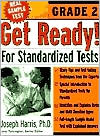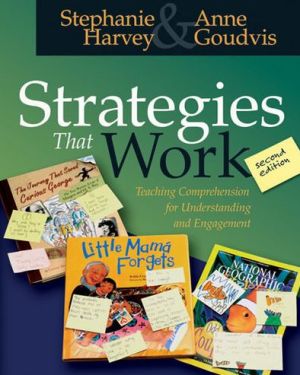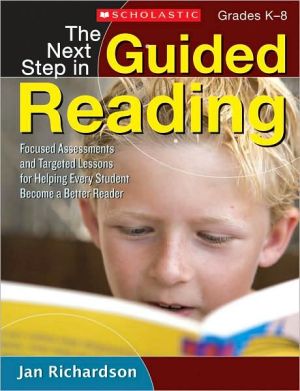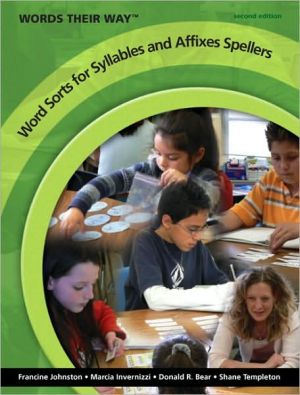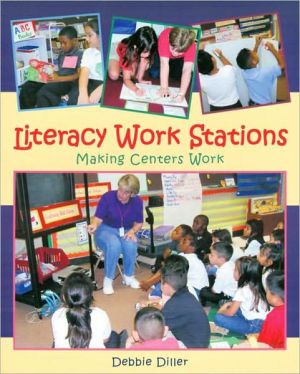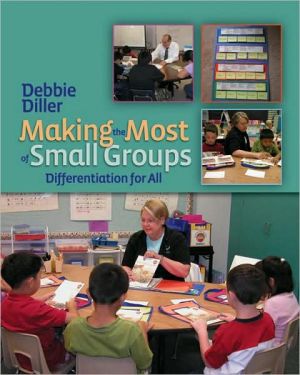Get Ready! For Standardized Tests, Vol. 3
With standardized, state-mandated testing starting as early as the first grade and continuing through high school, parents are concerned that their children may not be able to perform at grade level. Developed by professionals, here is the first and only grade-specific test preparation series geared toward parent and child, including expert tips for optimizing children's test performances.\ Features:\ \ Information on how schools use standardized tests\ Explanations of the types of questions...
Search in google:
On Your Mark for Grade 3The Grade-Specific Test Preparation Every Child Needs Remember those standardized tests you took back in grade school, filling in your answers with a number-two pencil, never knowing what became of your test results or even how well you fared? Now your child is taking those same tests, but this time you have the tools you need to help improve his or her test-taking skills and scores. Get Ready! For Standardized Tests is filled with empowering information for both you and your child. This grade-specific test preparation guide demystifies and explains the test your child will take. Get Ready! For Standardized Tests enables you to understand test results and helps you work with your child in all skill areas, helping to maximize his or her potential to succeed. Developed by educational professionals and McGraw-Hill, the nation's leading educational publisher, this guide is brimming with expert tips for optimizing your child's test performance to help even the most test-anxious child acquire the skills needed to excel at standardized exams. Everything parents must know to optimize their children's test performance! Only Get Ready! For Standardized Tests features: Practice exercises that stimulate questions from all state-mandated tests Verbal and math skill-enhancing exercises Actual tests with answers Study tips tailored to a child's grade level Because standardized tests are given at different times of the year, choosing the appropriate Get Ready! grade level is crucial to your child's preparation. If you are unsure as to which book is right for your child, consult with your child's teacher. Information includes: Phonics Multi-meaning words Fiction vs. nonfiction Homonyms Sequences Multi-digit computation Shapes and their properties and much more!
Chapter 1\ Test-Taking Basics\ \ As part of their educational careers, almost all children must take a series of standardized tests. During the early years, these tests can be very helpful in ensuring that your child is learning to the best of his or her ability. Standardized tests aren’t designed to be pass or fail, but rather to show a student’s areas of strength and areas that may need further development. This knowledge can be very useful to you and to your child’s teacher. In the school setting, skills often build on each other; if educational needs are identified as they emerge, a child is less likely to become frustrated or feel that learning is an overwhelming project. In addition, ignoring an early gap in learning can lead to repeated failure. By using the results of standardized tests in an informed way, you can help give your child the best possible educational experience.\ Standardized tests can be useful, but it’s also important to remember that they provide only one measure of a child’s work. Many factors can affect a child’s performance, only one of which is difficulty mastering the material. A child who is feeling ill, hungry, or tired is less likely to have the stamina for maintaining good focus. This might cause the child to miss one of the question spaces on the answer sheet, which will throw off all subsequent answers.\ Similarly, some children are particularly anxious during tests; worrying leaves less energy and thinking power for answering the questions, even though the child may know how to do the problem. Therefore, in order to understand the full significance of your child’s scores, it’s important to integrate them with information about your child’s classroom performance. Then any discrepancies can be explained in a more meaningful way.\ \ The Purpose of This Book\ This book is designed to familiarize you with the skills taught in a typical third-grade classroom. If you understand what your child is expected to learn, you will be in a better position to work with your child’s teacher. Educators believe that the most effective educational system is one in which parents and the school work together. The activities and suggestions in this book are not meant to take the place of your child’s teacher. It is important to remember that learning is an ongoing process. Time and practice can often be keys to success. Therefore, your reinforcing what is being taught in the classroom can be very helpful for your child.\ Before getting into specific strategies to help your child, it’s important to discuss how these strategies should be used. Most children want to do well. However, they spend many hours at school and often have daily homework to complete when they arrive home. In addition, many children are involved in organized activities outside of school. Additional educational activities such as the ones suggested here should not become all-encompassing; children need time to use their imaginations and to develop their own forms of play.\ When you carry out these activities, make them fun. You can be the student and your child can be the teacher. Explaining something to someone or checking what she did can be just as effective a learning tool as doing it yourself. So be the student, but make mistakes and have your child try to catch them.\ Be creative as you work on the skills. Look around you for real-world examples of the skills you are practicing. Information that is integrated into a meaningful framework is often easier to recall than that which is learned in isolation. Remember from your own school days when learning interesting subjects was easier than learning less interesting subjects? Most likely, the subjects you found interesting were the ones that were more meaningful to you.\ Another important key to success is to make sure your child doesn’t do too much at one time. Taking smaller, successful steps can be more effective than taking a giant step with lots of falling down. Your child should spend no more than about 20 minutes at a time on these activities, tempered by the amount of homework your child has for the day and any other outside commitments that have been scheduled (such as sports, religious classes, music lessons, or medical appointments). In order to avoid a time crunch, try to start these activities early; if you can, start when school begins in September. That way you can follow what the teacher is doing to help ensure that your child is mastering what is presented in class. Working over a longer period of time also makes the work less stressful for you and your child. It gives you lots of time to praise and encourage your child. Developing confidence goes a long way toward helping a child be successful!\ If your child resists your efforts, or you’re feeling frustrated with your child’s success in learning a skill presented in this book, stop the work and try to figure out what’s happening. Is the time fun? Are the activities creative and interesting? What is competing for your child’s attention? How long have you been working? If these factors don’t point to the problem, discuss your concerns with your child’s teacher. If your child is having similar problems at school, your teacher will be able to help you find out what the problem is. This book will not have served its purpose if all it does is create conflict and frustration.\ No book can cover every possible type of question on all standardized tests, nor can your child be expected to answer every question he may encounter. These tests are designed to include challenging questions for many of the students who take them. In addition, not all third-grade classes cover the same material. While there is certainly an overlap, the exact curriculum varies from one school to the next. The purpose of this book is to help you make sure your child understands the major concepts typical of a third-grade curriculum that are likely to be presented on a standardized test.\ \ The Third-Grade Student\ As your child turns 8, he or she enters what psychologists refer to as middle childhood. Children in this stage of development become better able to think flexibly and independently and, therefore, become ready for more advanced concepts within the curriculum. For example, when presented with several groups of objects, a third grader can understand that both quantities may be the same, despite differences in appearance. Children in middle childhood are less likely to be deceived by misleading physical cues. In addition, children at this stage begin to be able to shift their perspective so that a change in one dimension is understood as being compensated for by a change in another dimension. In other words, they understand that a tall, thin vase may hold the same amount of water as a short, fatter vase.\ Between the ages of 6 and 9, children gradually develop the capacity to perform mental operations. Being able to do things in their head, they can compare two sets of items, one of which includes the other. For example, children can now answer the question, "Are there more red flowers or flowers?" "Flowers" is a larger set, of which the red flowers are only one subset.\ Similarly, children this age can begin to think of elements that could belong to several categories at the same time. As a result of these changes in thinking skills, the curriculum becomes less tied to physical, concrete learning. Your child is entering the stage when she can grasp both concepts and the relationships between concepts. During this stage of development, children also become better able to understand the perspective of another person, while becoming more certain of their own responses; the group no longer sways them as it did before. At the same time, children at this age are becoming more adept at language. They are better at understanding the multiple meanings of words and are learning to apply logic without having to tie it to a concrete object or a specific content. They become better at remembering, which enhances the ability to summarize information and develop ways of classifying things. All of these changes are reflected in the curriculum.\ \ How to Help Your Child\ Your child will likely do better on standardized tests if she understands what to expect and can listen and follow directions. A child who doesn’t understand the directions or who is unfamiliar with the test format may not perform to the best of her ability. Therefore, it’s important to prepare your child for the logistics of the testing situation.\ Explain to your child that she’ll be asked to complete booklets in school to help find out what she has learned so far. Let your child know that this process will be different than other school days, because the classroom will likely be particularly quiet and the teacher won’t be able to help with the harder questions.\ Most standardized tests for this age are designed so that the directions are read to the class, with sample questions completed as a group before the class formally begins each section. After the sample questions are given, your child will be responsible for reading each individual question and for reading the response choices. Let your child know that a practice question will be given and, if she doesn’t understand what to do, it will be okay to ask the teacher to clarify the directions. (Note: The teacher may not be able to explain why the answer in the sample question is correct.)\ Prepare your child for the broad nature of the tests. Let her know that some of the questions will be easier than others. But even on the difficult questions, it will be important for your child to think about each choice before answering and to try to do her best. As you work with your child, remember that this book covers a great deal of curriculum information. All children don’t learn skills at the same pace; we all do some things better than others. In addition, standardized tests can’t include questions to assess every skill. Therefore, there will likely be only a few questions for each of the skills discussed in this book. This means that if your child isn’t 100 percent proficient in mastering place value, for example, his overall performance on the Math Concepts section may not necessarily be poor.\ Using a multiple-choice format, most standardized tests require students to fill in a small bubble near the correct answer. You’ll find a sample test at the end of this chapter (Sample Test A). If your child has difficulty with the format, make up your own sample test. Put in some easy questions to familiarize your child with the format, then include more difficult ones to help impress upon him that he needs to work carefully.\ It’s important that your child listen very carefully during the directions and during the reading of the questions. Some questions will be worded in a less obvious way: Which does not belong? Which could not happen? You can help your child by playing listening games, including memory games such as these two:\ \ 1. I’m going on a vacation and I’m going to take." The first person repeats the sentence and then adds an item. For each remaining turn, the person repeats the sentence beginning and lists all the previously stated items, then adds another item.\ \ You: I’m going on vacation and I’m going to take a baseball.\ \ Child: I’m going on vacation and I’m going to take a baseball and a book.\ \ As the list grows, it gets harder to recall the items and to do so in order. Playing games such as this helps to develop listening skills and auditory memory.\ \ 2. Giving instructions. Give your child sets of directions as you go through your typical day. Instead of telling your child to do one thing at a time, ask that he brush his teeth, put his clothes in the hamper, and get a book to read. You can make requests fun by throwing in tricks. "You need to go hang up your coat and if you sing a song, we can have some ice cream for dessert tonight," or "If you sing a song, we can play a game of UNO." Don’t give the ice cream or play UNO unless your child heard you the first time. If he asks "What?," tell him to try again next time.\ \ A sample test that focuses on following directions is included at the end of this chapter (Sample Test B). Remind your child to read directions carefully and not take anything for granted. It’s easy for children to assume that they know what to do. Help your child learn the following tips:\ • Do what the directions say, not what you think they mean.\ • Concentrate and reread the directions if you need to.\ • Ask a question if you don’t understand what to do.\ \ In addition to helping your child develop good listening skills, notice the kind of mistakes she makes as you work on the material presented in this book. Looking at mistakes can be a very productive way of understanding how a child is thinking, so that instruction can be made more effective. For example, look at the following incorrect answers:\ \ Find a word with the same vowel sound as weigh.\ Find a word with the same vowel sound as beam.\ \ In each case, the child chose the wrong response, but the pattern in the errors suggest that the child is looking at the letters within the words and not listening to how the words sound. \ It’s important for your child to work carefully and to consider all choices before choosing the correct one. Often this involves reciting the question with each response choice to see which is best. In the above examples, the child would say to herself:\ \ \ If your child is unsure of an answer, have him eliminate the ones he knows are incorrect. This gives him better odds of choosing the correct response.\ Look at your child’s papers from school. Does he follow directions carefully, or are parts omitted? Assess how your child follows directions at home. Do all of the steps get followed carefully, or are parts forgotten? Does she ask for clarification when needed?\ The tips presented here can be used for all schoolwork, not just for standardized tests; they’re just good study habits. The night before your child is tested, make sure she gets a good night’s sleep. Equally important, make sure she eats a healthy breakfast each morning. These are easy ways to reduce the artificial factors that can affect a child’s score.\ As you work through this book, you will find many different activities to do with your child. If a particular activity is especially enjoyable, feel free to adapt it to any of the other concepts. All children don’t enjoy the same types of activities, and only you know your child best. If your child’s teacher has presented a particular activity that your child enjoys, use that to reinforce the concepts, adapting it as possible. Remember that it’s not necessary to complete this book from start to finish. Perhaps your child enjoys doing more difficult things first. Another child might benefit from having extra practice with math, because he’s not as strong in that subject. He may want to start with the math chapters so there is extra time to review. A checklist is provided at the beginning of this book so you can keep track of the areas you work on, regardless of the order in which you do so.\ \ A Final Word\ Not everything that is taught in third grade—or that could possibly be on a given standardized test—can be included in one book. Trying to teach "everything" to your child is an impossible task, and would require a book too lengthy to be practical. The information presented here should be used in conjunction with the work that your child is doing in school to help develop essential skills in reading, written expression, and mathematics.\ Given that children learn academic concepts at different rates, and given that everyone has areas of strength and areas that are less developed, focus your attention on those skills that your child needs additional practice in, with periodic review of the other areas.\ Sample questions are included with each chapter. These questions are designed to help familiarize your child with the types of questions that may be on a given standardized test. These questions are not a measure of your child’s proficiency in any given content area; but if your child is having difficulty with a particular question, use that information to determine what skills she needs extra practice in.\ From your own experience, you may remember that curriculum areas overlap. As a result, questions on a particular skill may be found in a different chapter than expected. For example, adding a verb ending is discussed in Chapter 2, Word Analysis, but questions on verb endings appear in Chapter 5: Language Mechanics. There is no set way you must work through this book. Instead, use it as a resource to help you work with your child.\
Chapter 1: Test-Taking Basics. Chapter 2: Vocabulary. Chapter 3: Reading Comprehension. Chapter 4: Language Mechanics. Chapter 5: Language Expression. Chapter 6: Spelling and Study Skills. Chapter 7: Math Concepts. Chapter 8: Math Computation. Chapter 9: Math Applications. Sample Practice Test. Student Answer Sheet. Appendices. Glossary. Answer Key.
